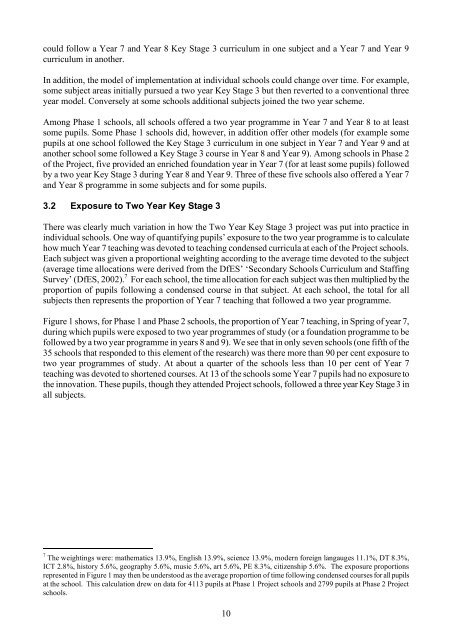Evaluation of the Two Year Key Stage 3 Project - Communities and ...
Evaluation of the Two Year Key Stage 3 Project - Communities and ...
Evaluation of the Two Year Key Stage 3 Project - Communities and ...
You also want an ePaper? Increase the reach of your titles
YUMPU automatically turns print PDFs into web optimized ePapers that Google loves.
could follow a <strong>Year</strong> 7 <strong>and</strong> <strong>Year</strong> 8 <strong>Key</strong> <strong>Stage</strong> 3 curriculum in one subject <strong>and</strong> a <strong>Year</strong> 7 <strong>and</strong> <strong>Year</strong> 9curriculum in ano<strong>the</strong>r.In addition, <strong>the</strong> model <strong>of</strong> implementation at individual schools could change over time. For example,some subject areas initially pursued a two year <strong>Key</strong> <strong>Stage</strong> 3 but <strong>the</strong>n reverted to a conventional threeyear model. Conversely at some schools additional subjects joined <strong>the</strong> two year scheme.Among Phase 1 schools, all schools <strong>of</strong>fered a two year programme in <strong>Year</strong> 7 <strong>and</strong> <strong>Year</strong> 8 to at leastsome pupils. Some Phase 1 schools did, however, in addition <strong>of</strong>fer o<strong>the</strong>r models (for example somepupils at one school followed <strong>the</strong> <strong>Key</strong> <strong>Stage</strong> 3 curriculum in one subject in <strong>Year</strong> 7 <strong>and</strong> <strong>Year</strong> 9 <strong>and</strong> atano<strong>the</strong>r school some followed a <strong>Key</strong> <strong>Stage</strong> 3 course in <strong>Year</strong> 8 <strong>and</strong> <strong>Year</strong> 9). Among schools in Phase 2<strong>of</strong> <strong>the</strong> <strong>Project</strong>, five provided an enriched foundation year in <strong>Year</strong> 7 (for at least some pupils) followedby a two year <strong>Key</strong> <strong>Stage</strong> 3 during <strong>Year</strong> 8 <strong>and</strong> <strong>Year</strong> 9. Three <strong>of</strong> <strong>the</strong>se five schools also <strong>of</strong>fered a <strong>Year</strong> 7<strong>and</strong> <strong>Year</strong> 8 programme in some subjects <strong>and</strong> for some pupils.3.2 Exposure to <strong>Two</strong> <strong>Year</strong> <strong>Key</strong> <strong>Stage</strong> 3There was clearly much variation in how <strong>the</strong> <strong>Two</strong> <strong>Year</strong> <strong>Key</strong> <strong>Stage</strong> 3 project was put into practice inindividual schools. One way <strong>of</strong> quantifying pupils’ exposure to <strong>the</strong> two year programme is to calculatehow much <strong>Year</strong> 7 teaching was devoted to teaching condensed curricula at each <strong>of</strong> <strong>the</strong> <strong>Project</strong> schools.Each subject was given a proportional weighting according to <strong>the</strong> average time devoted to <strong>the</strong> subject(average time allocations were derived from <strong>the</strong> DfES’ ‘Secondary Schools Curriculum <strong>and</strong> StaffingSurvey’ (DfES, 2002). 7 For each school, <strong>the</strong> time allocation for each subject was <strong>the</strong>n multiplied by <strong>the</strong>proportion <strong>of</strong> pupils following a condensed course in that subject. At each school, <strong>the</strong> total for allsubjects <strong>the</strong>n represents <strong>the</strong> proportion <strong>of</strong> <strong>Year</strong> 7 teaching that followed a two year programme.Figure 1 shows, for Phase 1 <strong>and</strong> Phase 2 schools, <strong>the</strong> proportion <strong>of</strong> <strong>Year</strong> 7 teaching, in Spring <strong>of</strong> year 7,during which pupils were exposed to two year programmes <strong>of</strong> study (or a foundation programme to befollowed by a two year programme in years 8 <strong>and</strong> 9). We see that in only seven schools (one fifth <strong>of</strong> <strong>the</strong>35 schools that responded to this element <strong>of</strong> <strong>the</strong> research) was <strong>the</strong>re more than 90 per cent exposure totwo year programmes <strong>of</strong> study. At about a quarter <strong>of</strong> <strong>the</strong> schools less than 10 per cent <strong>of</strong> <strong>Year</strong> 7teaching was devoted to shortened courses. At 13 <strong>of</strong> <strong>the</strong> schools some <strong>Year</strong> 7 pupils had no exposure to<strong>the</strong> innovation. These pupils, though <strong>the</strong>y attended <strong>Project</strong> schools, followed a three year <strong>Key</strong> <strong>Stage</strong> 3 inall subjects.7 The weightings were: ma<strong>the</strong>matics 13.9%, English 13.9%, science 13.9%, modern foreign langauges 11.1%, DT 8.3%,ICT 2.8%, history 5.6%, geography 5.6%, music 5.6%, art 5.6%, PE 8.3%, citizenship 5.6%. The exposure proportionsrepresented in Figure 1 may <strong>the</strong>n be understood as <strong>the</strong> average proportion <strong>of</strong> time following condensed courses for all pupilsat <strong>the</strong> school. This calculation drew on data for 4113 pupils at Phase 1 <strong>Project</strong> schools <strong>and</strong> 2799 pupils at Phase 2 <strong>Project</strong>schools.10

















